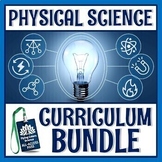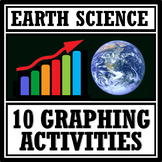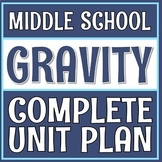Gravity Activity Graph Mass Distance Gravitational Interactions PRINT and GOOGLE
Flying Colors Science
4.8k Followers
Grade Levels
7th - 10th
Subjects
Resource Type
Standards
NGSSMS-PS2-4
NGSSMS-ESS1-2
NGSSHS-PS2-4
Formats Included
- PDF
- Google Apps™
Pages
12 pages
Flying Colors Science
4.8k Followers

Includes Google Apps™
The Teacher-Author indicated this resource includes assets from Google Workspace (e.g. docs, slides, etc.).
What educators are saying
Completely aligned with MS-PS2-4. Practice with graphing and seeing patterns in order to understand relationships.
This is a great resource. I used for review in most of my classes. My students find very helpful and understandable.
Also included in
- Save more than 40% off list prices! This bundle includes 8 high-interest activities on the universe, the sun, gravity, the solar system, galaxies, and astronauts. These space lessons are designed to add FUN and RIGOR to an existing astronomy unit! This Bundle Includes the Following:Galaxy Types ClaPrice $19.99Original Price $34.43Save $14.44
- Never search for "something to do tomorrow" ever again! This bundle contains PRINT AND GO lessons, NO PREP activities, LOW PREP labs, and ENGAGING articles to supplement and thoroughly enhance an Earth and space science course. Every included resource is easy to implement, standards-based, and high-Price $399.99Original Price $649.02Save $249.03
- Never search for "something to do tomorrow" ever again! This bundle contains PRINT AND GO lessons, NO PREP activities, LOW PREP labs, and ENGAGING articles to supplement and thoroughly enhance a physical science course. Every included resource is easy to implement, standards-based, and high-quality.Price $399.99Original Price $671.34Save $271.35
- SAVE OVER 30% off list prices! Add SCIENCE GRAPHING SKILLS PRACTICE across your Earth and Space science curriculum! Each activity addresses an NGSS Earth or Space science standard while helping students get more experience graphing data. Every resource is a little different than the next, and thePrice $29.99Original Price $44.41Save $14.42
- SAVE 50% OFF LIST PRICES! This complete gravity unit focuses ONLY ON GRAVITY and includes 8 high-quality lessons to teach and assess gravity at the middle school level! The included gravity activities are both engaging and rigorous. Plus, all included resources have both print and digital options tPrice $19.00Original Price $38.20Save $19.20
Description
Students graph MASS and DISTANCE vs. GRAVITY to understand gravitational interactions and then complete a detailed analysis worksheet.
Includes PRINT and GOOGLE SLIDES versions!
⭐ Get this resource at a HUGE discount in our done-for-you Gravity Unit!
This gravity activity has students investigate the particles of Saturn's rings to determine the relationship between mass and gravity, and distance and gravity. There are several sections:
- Part 1: Introduction
- Part 2: Provides a data table of ring particles' masses and gravitational forces. Students analyze the data table for trends and then graph the data on a provided graph.
- Part 3: Provides a data table of ring particles' distances from Saturn and gravitational force. Analyze the data for trends and then graph the data on a provided graph.
- Part 4: Several analysis questions, including a claims/evidence/reasoning table, all of which focus on the relationship between mass and gravity, and distance and gravity.
Teacher Notes:
- This activity is DIFFERENTIATED: Two versions are provided - one with the graph axes pre-labeled and one where the students must label the graph axes themselves. This activity is appropriate for upper middle school and high school.
- This activity is 6 pages long (3 front/back). Each specific section is exactly 1 page front and back, so it is convenient to copy and complete one section at a time.
- Although this activity has a space-based theme, it is appropriate for any unit covering gravity.
- Includes answer key.
- Please note: This resource is NOT editable.
- NGSS Standards: MS-PS2-4 and MS-ESS1-2
- NGSS Science & Engineering Practices: Analyzing and interpreting data; Engaging in argument from evidence
⭐⭐⭐ Click here to get 5 FREE EARTH & SPACE SCIENCE lessons! ⭐⭐⭐
Total Pages
12 pages
Answer Key
Included
Teaching Duration
N/A
Report this resource to TPT
Reported resources will be reviewed by our team. Report this resource to let us know if this resource violates TPT’s content guidelines.
Standards
to see state-specific standards (only available in the US).
NGSSMS-PS2-4
Construct and present arguments using evidence to support the claim that gravitational interactions are attractive and depend on the masses of interacting objects. Examples of evidence for arguments could include data generated from simulations or digital tools; and charts displaying mass, strength of interaction, distance from the Sun, and orbital periods of objects within the solar system. Assessment does not include Newton’s Law of Gravitation or Kepler’s Laws.
NGSSMS-ESS1-2
Develop and use a model to describe the role of gravity in the motions within galaxies and the solar system. Emphasis for the model is on gravity as the force that holds together the solar system and Milky Way galaxy and controls orbital motions within them. Examples of models can be physical (such as the analogy of distance along a football field or computer visualizations of elliptical orbits) or conceptual (such as mathematical proportions relative to the size of familiar objects such as students’ school or state). Assessment does not include Kepler’s Laws of orbital motion or the apparent retrograde motion of the planets as viewed from Earth.
NGSSHS-PS2-4
Use mathematical representations of Newton’s Law of Gravitation and Coulomb’s Law to describe and predict the gravitational and electrostatic forces between objects. Emphasis is on both quantitative and conceptual descriptions of gravitational and electric fields. Assessment is limited to systems with two objects.










